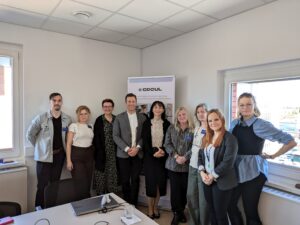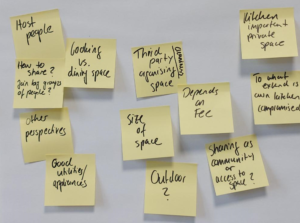
This blog explores the dynamics of sharing in co-working (short: CW) spaces, using a Dublin-based office in Ireland, as a case study. While the CDCUL project primarily examines shared spaces and services in residential neighborhoods — including communal kitchens, workshops, cargo bikes, and study-work spaces — this post takes a closer look at how members of a large co-working space share amenities, navigate interactions, and manage conflicts. Understanding these practices could provide valuable insights for developing effective management systems for shared spaces.
Dublin case study – context
Dublin, also known as the Silicon Valley of Europe, is a city which has a rich history of grass root as well as corporate co-working organizations. These insights are based on an anthropological case study, conducted in one of the city’s longest running CWs (Babuder, 2024). The research dealt with the question of how space affects the feelings of belonging and productivity in a communal working space, especially after the pandemic. This topic led to many conversations on sharing space, material amenities and immaterial resources, from which relevant findings for the CDCUL project will be presented below.
This particular CW was founded by a group of architects and designers in 2009 and was signified by close connections among members, creativity, activities, extensive collaborations and a comfortable, reliable atmosphere. The organization was set up in a former industrial hall, where one large space contained:
- 50 fixed desk spaces (meaning a desk was assigned to a specific person, who could leave their computer and other belongings there),
- hot-desk spaces (anyone can sit anywhere in that area),
- meeting rooms available for booking,
- a storefront room for events, exhibitions and occasionally ping-pong and games,
- a small loft library for relaxation and
- a large communal kitchen, with a spacious dining table.
How people shared the space
Meeting rooms were the only “private area” in the large industrial hall, booked ahead of time. Members used it for meetings, in-person and online or longer phone calls. If any mistakes, misunderstandings or mismanagement happened, it was usually handled face-to-face in the office.
Desks could be individual, shared by two people or available for “hot-desking,” free for anyone to use. Desks with designated users fostered neighborly relationships while shared desks facilitated new connections between non-regular members.
The kitchen was the liveliest place in the office. Since it opened into the working space, sounds from the kitchen were present in all corners of the office, contributing to the “hum” of the office, which members sometimes even described as a nice feeling of presence of other people and homeliness. Of course, members respected each other by not causing a big racket during “work hours,” but around 1pm, during lunch time, the kitchen invited conversation, cooking and enjoying meals together. Members described how gathering in the kitchen for meals or coffee breaks made it easier to relax and recharge… Sharing food was also a common practice – travelers often brought back snacks and sweets to share, further strengthening social bonds.
The process of claiming the space also played a role in the good atmosphere of the environment at the CW. Most of the renovations and bigger projects in the office were done with the volunteer help of the regular members, which strengthened the feeling of place attachment, community belonging and responsibility for space and organization. One illustrative example was the renovation of a “store-front” room, which was a larger separate room used for hosting bigger events (approx. 50 people), game breaks and even ping-pong when it was empty. This room brought together elements of play, education and entertainment into the working environment. The once-empty room was transformed into a dynamic space that symbolized collective achievement.
Sharing material resources
Alongside sharing spaces, members often borrowed from each other cables, books, coffee and milk, which was communicated in person (by someone stepping to the others desk and asking for it) or sending a question into the WhatsApp group chat, where everyone could respond. These small events of exchange and reciprocity offered opportunities for small talk, which led to other conversations and deepening the relationships and collaborations between people on-site.
Sharing immaterial resources
Some members joined the organization early in their career and grew together with the organization, developing close relationships that stretched outside of working collaborations, even fostering a feeling of a “second family.” While a coworking space is a purely professional environment at first glance, spending every day together, mentoring each other, giving and asking for advice, creating the program and the space together (mostly on voluntary basis) were factors contributing to individuals forming a collective feeling. In turn, this feeling of belonging became a key reason to commute and work in the office even when the weather or traffic was horrible and even when there was no pressing obligation to leave the house that day. This highlights what motivations, beyond utility, drive certain, more regular uses of a space or a service.
Understanding how sharing spaces creates community
The sense of belonging and community are one of the key factors for feeling good and at ease in a place, whether that is an office, a neighborhood or a house. When considering future living and urban spaces, it is useful to look at how space itself can facilitate different types of relationships between people using it. How will they manage it together? In what way will they spend time there? And with whom? – are questions that affect how these spaces should be set up.
In Dublin’s CW for example, the kitchen represented the heart of the place, where members met once a day during lunch, talked and prepared food and coffee together. This created a home-like feeling in the office, along with a feeling of belonging. In contrast, their previous location had a smaller kitchen and a divided two-floor layout which created a sense of hierarchy and separation.
This was obviously not a feeling to encourage in a co-working space, which thrives on collaboration and good relations. Once this was acknowledged, the new location (where everything was in one large open space) gained new value for creating a good atmosphere.
Lessons for designing shared spaces
Understanding how people share and interact within a space is essential for designing environments that promote collaboration and well-being. Whether planning a co-working office, a community hub, or a residential complex, engaging directly with users through interviews, focus groups, and observations can reveal valuable insights.
Ultimately, the case of Dublin’s CW demonstrates that a strong sense of community stems from regular face-to-face interactions in the space, shared responsibilities, and mutual care for the space. These lessons can inspire more effective management systems for communal spaces, ensuring they remain vibrant, inclusive, and conducive to meaningful connections.
Blog Author: Anuša Babuder
Reference
BABUDER, Anuša, 2024, Work, flexibility and coworking: An anthropological study of communal working spaces in Dublin during and after Covid-19 pandemic [online]. Master’s thesis. Retrieved from: https://repozitorij.uni-lj.si/IzpisGradiva.php?lang=eng&id=159332



